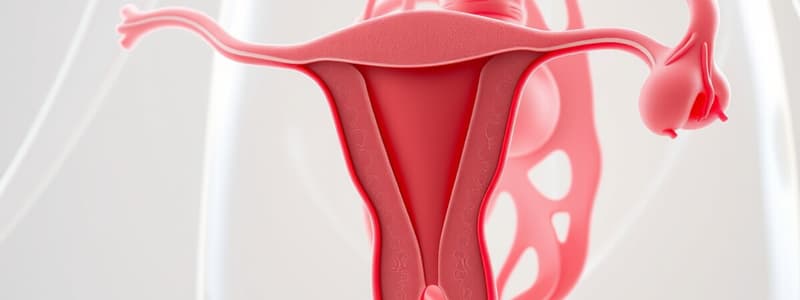Podcast
Questions and Answers
What are primary sexual characteristics?
What are primary sexual characteristics?
- The presence of male/female reproductive parts (correct)
- Hormonal changes during puberty
- Secondary traits that develop post-birth
- Physical adaptations for survival
Which of the following is NOT a function of the epididymis?
Which of the following is NOT a function of the epididymis?
- Transports sperm to the vas deferens
- Produces testosterone (correct)
- Stores sperm
- Matures sperm
What is the main function of the fallopian tube?
What is the main function of the fallopian tube?
- Produces hormones necessary for ovulation
- Stores eggs until ovulation
- Site of implantation for the fertilized egg
- Transports the egg to the uterus and is the site of fertilization (correct)
Which hormone is produced in the corpus luteum?
Which hormone is produced in the corpus luteum?
How long is the average menstrual cycle?
How long is the average menstrual cycle?
What is the survival time for sperm after ejaculation?
What is the survival time for sperm after ejaculation?
Which of the following does NOT describe a secondary sexual characteristic?
Which of the following does NOT describe a secondary sexual characteristic?
What is the function of the vagina?
What is the function of the vagina?
Which hormone is responsible for the regulation of the menstrual cycle?
Which hormone is responsible for the regulation of the menstrual cycle?
What is the main function of the ectoderm layer during embryonic development?
What is the main function of the ectoderm layer during embryonic development?
Which secondary sexual characteristic is typically observed in males?
Which secondary sexual characteristic is typically observed in males?
Which statement best describes fertilization?
Which statement best describes fertilization?
What typically occurs during the 12th week of pregnancy?
What typically occurs during the 12th week of pregnancy?
Which of the following best defines infertility?
Which of the following best defines infertility?
What is considered a natural form of contraception?
What is considered a natural form of contraception?
Which of the following systems is the mesoderm responsible for producing?
Which of the following systems is the mesoderm responsible for producing?
What does copulation specifically refer to in human reproduction?
What does copulation specifically refer to in human reproduction?
What is a common cause of male infertility?
What is a common cause of male infertility?
What forms the placenta during pregnancy?
What forms the placenta during pregnancy?
In what stage do the three stages of birth occur?
In what stage do the three stages of birth occur?
Flashcards are hidden until you start studying
Study Notes
Human Reproductive System Overview
- Primary sexual characteristics refer to the presence of male and female reproductive organs.
- Secondary sexual characteristics emerge at puberty and distinguish sexes without affecting reproduction.
Male Reproductive System
- Secondary sexual characteristics in males include:
- Enlargement of the larynx (deepening of voice)
- Development of pubic and facial hair
- Broadening of shoulders
- Epididymis functions to mature and store sperm.
- Urethra carries urine and sperm out of the body.
- The penis serves to deposit sperm into the female reproductive tract.
- Sperm are haploid, containing half the genetic material.
- High mitochondrial count in sperm provides energy needed to swim towards the egg.
Female Reproductive System
- Primary hormones in females include progesterone and estrogen.
- Examples of female secondary sexual characteristics:
- Enlargement of breasts
- Production of pubic hair
- Widening of pelvis
- Fallopian tubes transport the egg to the uterus and are the site of fertilization.
- Endometrium is the uterine lining where implantation occurs.
- The vagina allows for sperm entry and acts as the birth canal.
Hormones and Menstrual Cycle
- Follicle-stimulating hormone (FSH) is produced by the pituitary gland.
- Progesterone is produced by the corpus luteum.
- The menstrual cycle typically lasts 28 days, regulated by estrogen, progesterone, FSH, and luteinizing hormone (LH).
- The fertile period is when fertilization is most likely.
- Survival time for sperm is 0-7 days, whereas egg survival is 0-48 hours.
Menstrual Disorders
- Endometriosis is a disorder characterized by endometrial tissue outside the uterus; treatments include pain medication and hysterectomy.
Gametes Comparison
- Male gametes (sperm) outnumber female gametes (eggs); males produce sperm continuously while females produce eggs monthly.
- Egg cells are larger, while sperm cells are significantly smaller.
Reproductive Processes
- Arousal is when the penis becomes erect and lubrication occurs in the vagina.
- Copulation is the act of penile insertion into the vagina.
- Fertilization involves the fusion of sperm and egg nuclei, resulting in a diploid zygote.
- Implantation is the embedding of a fertilized egg into the uterine lining.
Embryonic Development
- The three germ layers are ectoderm, mesoderm, and endoderm.
- Ectoderm develops into skin, nails, hair, and the nervous system.
- Mesoderm gives rise to muscles, skeleton, excretory, respiratory, circulatory, and reproductive systems.
- Major organs and sex organs develop by the 6th week of pregnancy.
- The gender of the fetus can be identified by the 12th week.
Stages of Birth
- Birth occurs in three stages: labor, parturition, and afterbirth.
Contraception and Infertility
- Contraception involves preventing conception; examples include:
- Natural: abstinence or avoiding intercourse around ovulation.
- Chemical: contraceptive pill or spermicide.
- Surgical: vasectomy or surgical sterilization of fallopian tubes.
- Infertility is defined as the inability to conceive naturally.
- Male infertility often results from low sperm count, with potential causes including drug/alcohol abuse and stress.
- Female infertility can stem from various factors not detailed here.
Studying That Suits You
Use AI to generate personalized quizzes and flashcards to suit your learning preferences.



